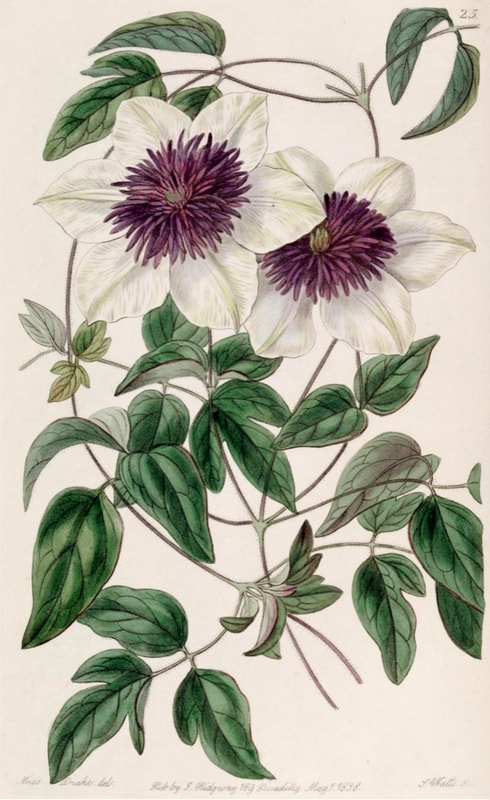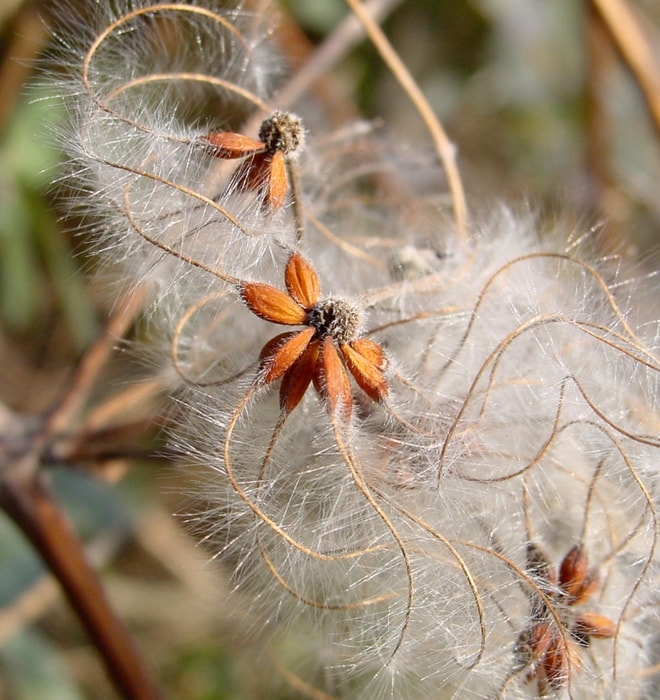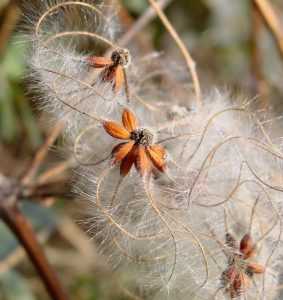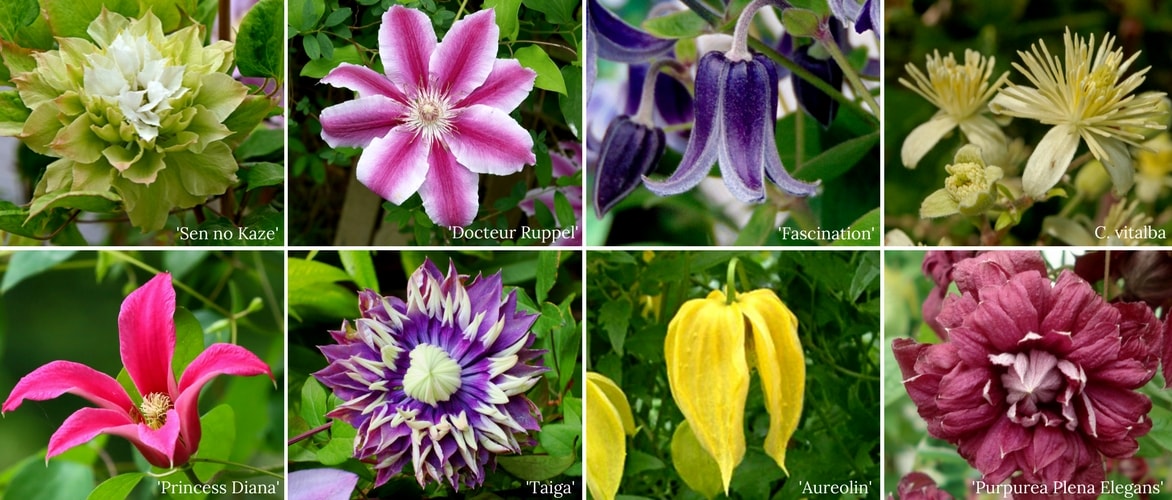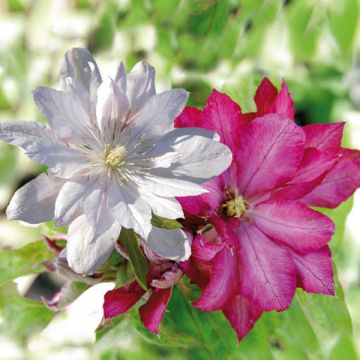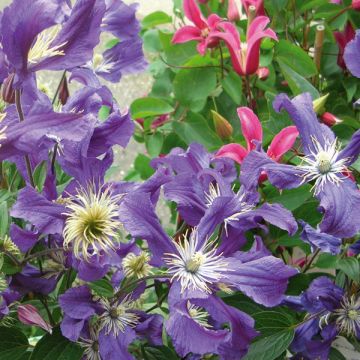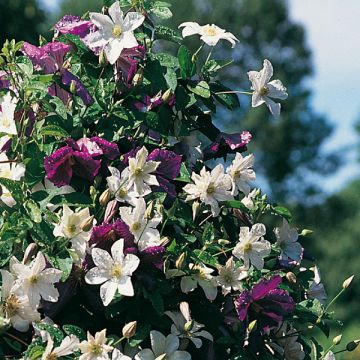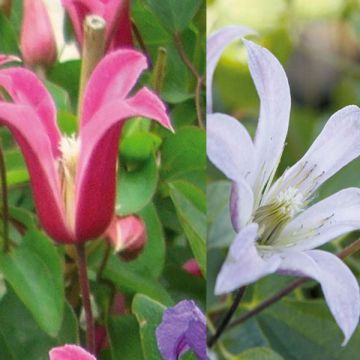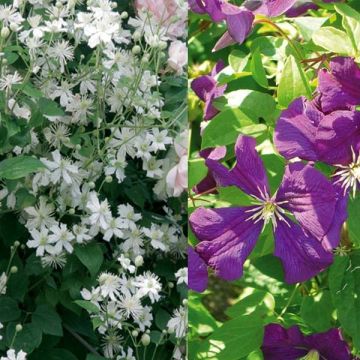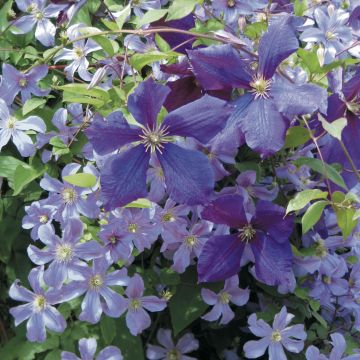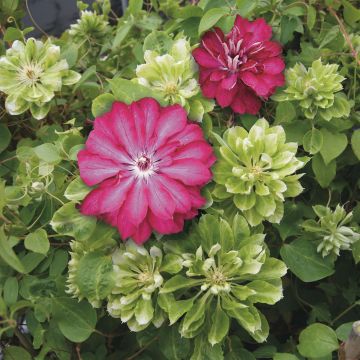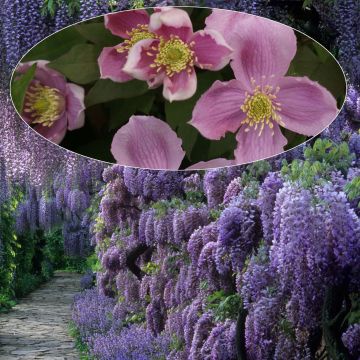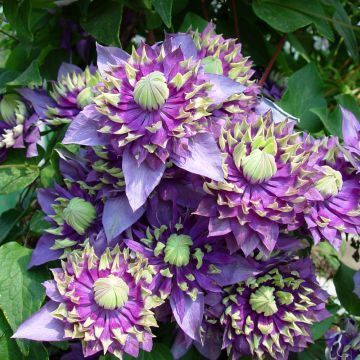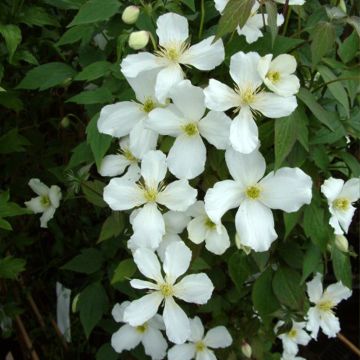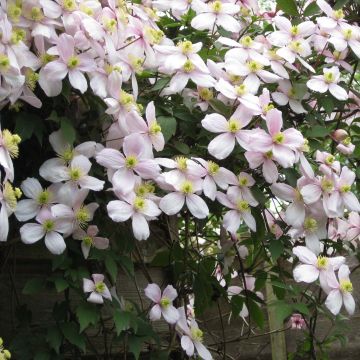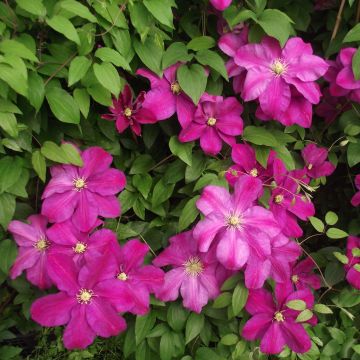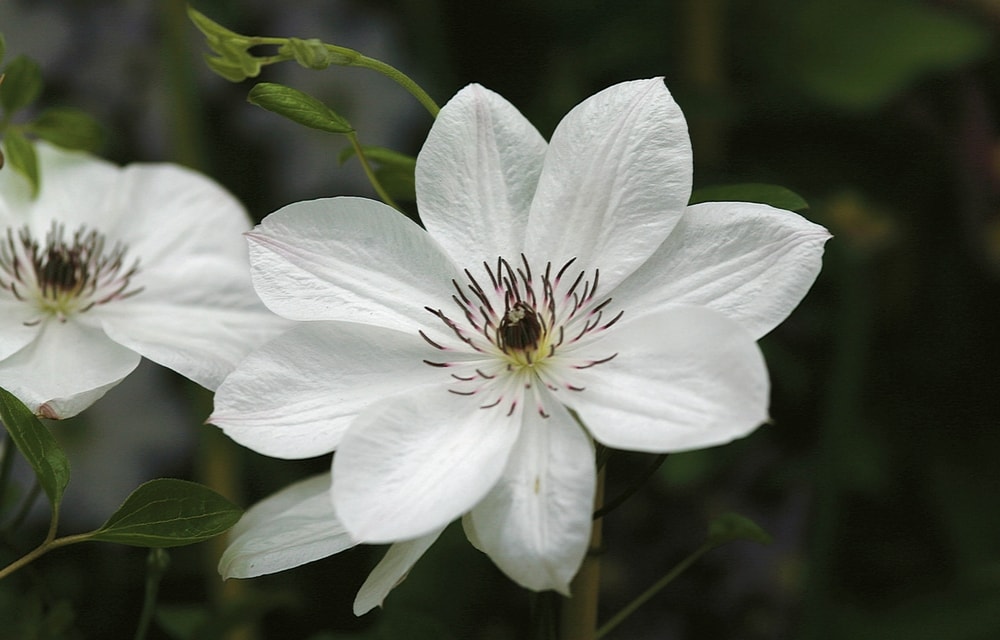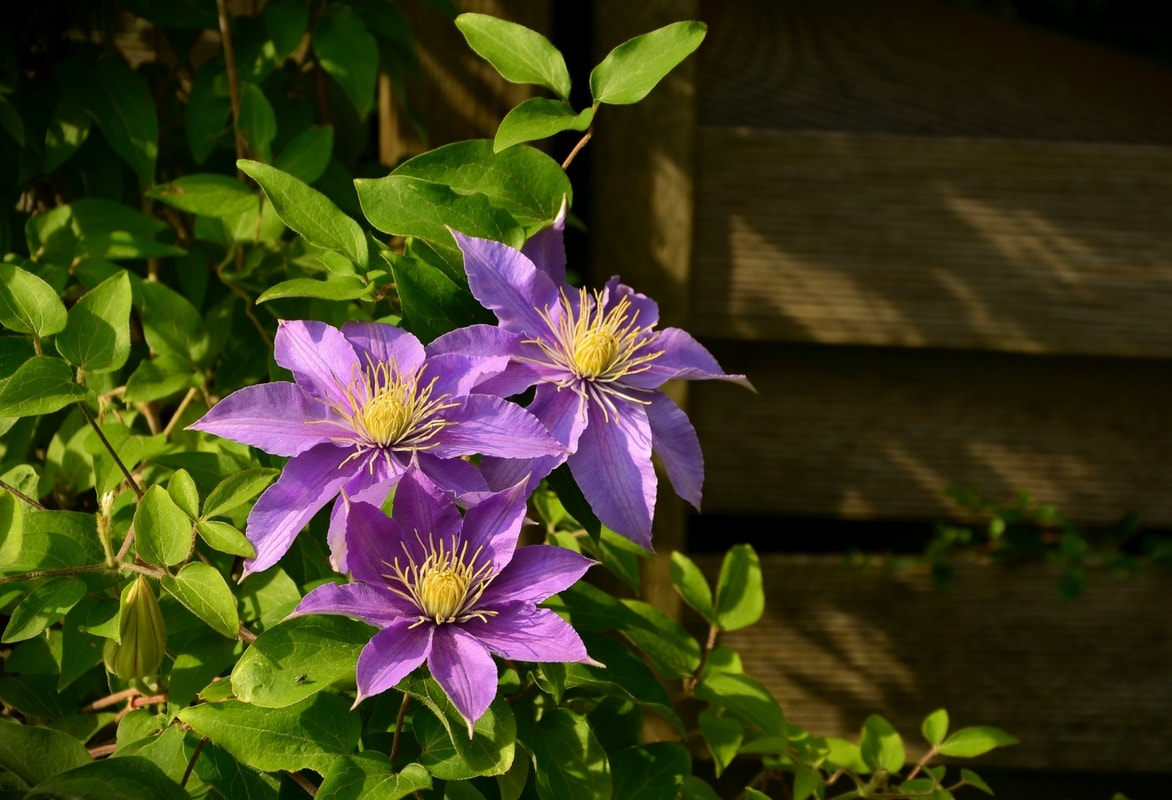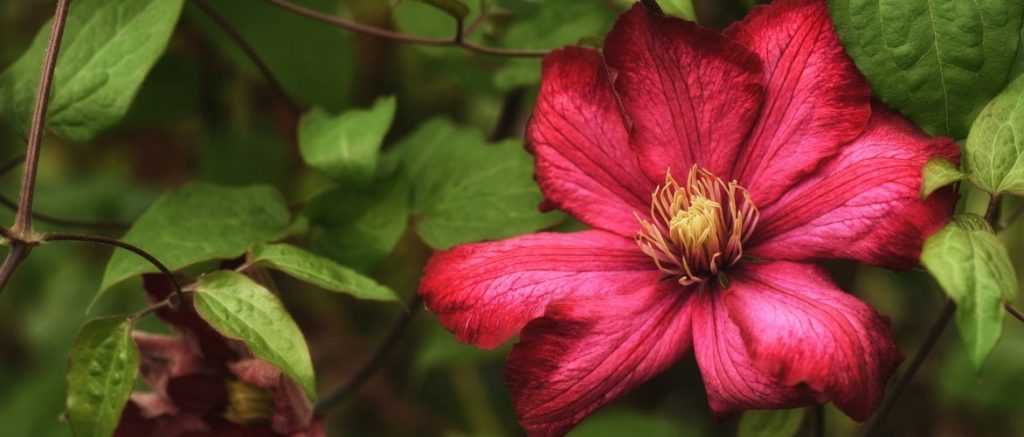
Clematis: Planting, Pruning and Care
Contents
Clematis in a nutshell
- Clematis are renowned for their star-shaped flowers, which can be fragrant
- These plants offer a wide range of colours and forms, perfect for all garden styles
- Their delicate appearance adds a romantic touch, especially when combined with other plants like roses
- Some varieties, such as Clematis armandii and Clematis cirrhosa, retain their foliage year-round
- Ideal for small spaces, they can be grown in pots to adorn patios and balconies
Our Expert's Word
Clematis is a climbing plant that has much to offer, but also requires some attention. Its spectacular flowering makes it the queen of climbers, capable of transforming any space into a fairytale garden. The different varieties provide staggered flowering, ensuring a colourful display for almost the entire year.
However, clematis has its demands: it loves the sun but needs its roots in the shade. The soil should be well-drained yet kept moist, which may require mulching. It is also susceptible to certain diseases and pests, so regular monitoring is advised.
Pruning is another aspect not to be overlooked. Depending on the variety, it may need pruning just after flowering or in late spring for large-flowered types. Proper pruning will encourage more abundant and healthier blooms.
Finally, let’s not forget that clematis needs sturdy support for its twining stems. Whether it’s a pergola, fence, or even a tree, make sure to provide adequate support. For those short on space, the good news is that it can also be grown in pots, making it ideal for patios and balconies.
Botany of Clematis: A Fascinating Diversity
Botanical data
- Latin name Clematis sp.
- Family Ranunculaceae
- Common name Clematis
- Flowering from March for early varieties, until October
- Height 2 to 15 metres
- Exposure flowers in sun, base in shade
- Soil type deep, moist, well-drained
- Hardiness -20°C for most varieties
With nearly 300 species and 400 cultivated varieties, clematis offer remarkable diversity! This genus includes climbing plants, small perennials and even shrubs. The most common garden varieties are large-flowered climbers, but non-climbing clematis are also cultivated.
Native to Europe, Asia, Australia, and North/Central America, many species originate from China. In France, the Old Man’s Beard (Clematis vitalba) commonly grows in hedgerows and woodland edges – you’ve certainly encountered it! Its long, flexible stems are used in basket weaving.
Belonging to the Ranunculaceae family (which includes hellebores, delphiniums and columbines), its name derives from Greek Klema, meaning “flexible shoot”.
Clematis are fast-growing climbing plants that use twisting leaf stalks to grip supports. Unlike self-clinging ivy, they require trellises or frameworks to climb.
Most varieties reach 2-4 metres, though some attain 15m. Non-climbing types like C. heracleifolia, C. integrifolia and C. recta grow as perennials, while others trail or cascade from containers.
Clematis flowers display extraordinary diversity – from exuberant, brightly-coloured cascades to delicate, subtle blooms like C. fusca. The unusual winter-flowering C. cirrhosa produces small bicoloured flowers (white with purple spots). Species with bell-shaped blooms offer wild, natural charm. Flower diameter ranges from 2cm to 20cm in some hybrids.
Flower forms vary dramatically. Single blooms appear natural and simple, while doubles seem sophisticated. Atragene group clematis produce charming spring bell-flowers, while unusual varieties like ‘Octopus’ feature long, spreading violet sepals. Some resemble tulip flowers.
Interestingly, the colourful parts are sepals (4-10 per flower), not petals. Typically pink, white, blue or violet (sometimes red), they create soft, romantic effects. Yellow varieties like C. tangutica also exist. Dark sepals often contrast beautifully with prominent stamens.
Some clematis produce fragrant blooms, like orange blossom-scented C. armandii ‘Apple Blossom’.
Flowering periods vary by variety – spring through autumn, with winter blooms from C. cirrhosa types. C. armandii flowers as early as March, while late varieties continue until October. Some reblooming cultivars flower twice annually!
Modern diversity stems partly from Japanese C. patens, which revolutionised hybridisation. These varieties (including famous ‘Dr Ruppel’ and ‘Nelly Moser’) often bloom spring and late summer.
Foliage varies from simple to divided leaflets, with smooth or toothed edges. C. armandii has leathery, glossy leaves. Most garden clematis are deciduous, though some (like C. armandii) are evergreen.
Distinctive decorative seedheads feature feathery plumes attached to each seed. Most clematis tolerate -15°C to -20°C, except less hardy cirrhosa types.
Clematis are divided into three pruning groups:
- Early-flowering types bloom on previous year’s growth. Includes C. alpina, C. montana, C. macropetala and evergreens like C. armandii and C. cirrhosa.
- Large-flowered early varieties that flower on old wood in spring, then new growth in summer. Examples: ‘Nelly Moser’, ‘Dr Ruppel’ and C. florida.
- Late large-flowered varieties blooming on current season’s growth. Includes ‘Jackmanii’, C. terniflora, C. viticella, C. tangutica and herbaceous types.
Botanical Species
Our native wild clematis, common in French hedgerows and woodland edges. Bears fragrant white flowers followed by feathery seedheads. Its long stems are used in basketry.
- Clematis montana
This vigorous Himalayan species flowers profusely in spring. The pink-flowered ‘Mayleen’ is particularly striking.
- Clematis viticella
Produces abundant small blue/purple summer flowers. Parent to hybrids like ‘Mme Julia Correvon’ and ‘Étoile Violette’.
- Clematis alpina
Another early bloomer with violet bell-flowers and ornamental seedheads.
The main varieties of clematis
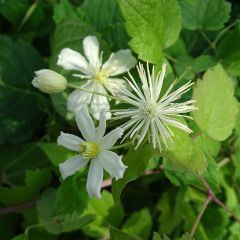
Clematis fargesii Summersnow
- Flowering time August to October
- Height at maturity 5 m
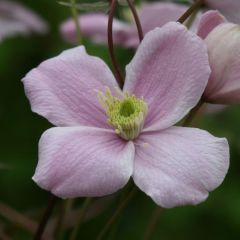
Clematis montana Mayleen
- Flowering time June
- Height at maturity 8,10 m
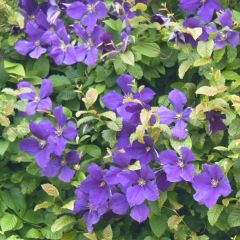
Clematis jackmanii - Clematis vine
- Flowering time July to October
- Height at maturity 3 m
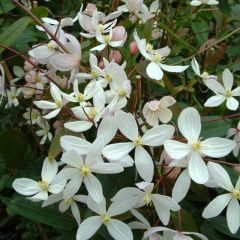
Clematis armandii Apple Blossom
- Flowering time April, May
- Height at maturity 4 m
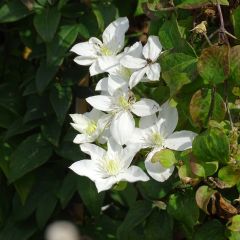
Clematis integrifolia Baby Star 'Zobast'
- Flowering time June to October
- Height at maturity 1,50 m
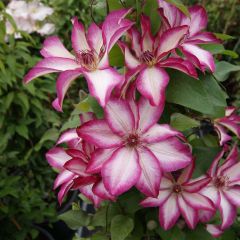
Clematis Picotee
- Flowering time June to October
- Height at maturity 2 m

Clematis terniflora
- Flowering time September to November
- Height at maturity 4 m
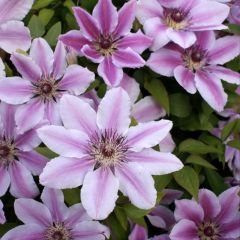
Clematis lanuginosa Nelly Moser
- Flowering time June to October
- Height at maturity 3 m

Clematis viticella Astra nova
- Flowering time July to October
- Height at maturity 2,50 m
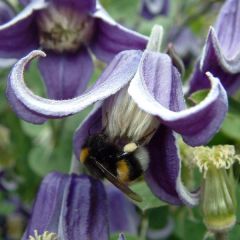
Clematis diversifolia Fascination
- Flowering time July to September
- Height at maturity 1,50 m
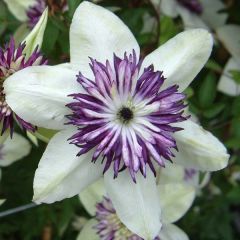
Clematis florida Sieboldii
- Flowering time June to August
- Height at maturity 2,50 m
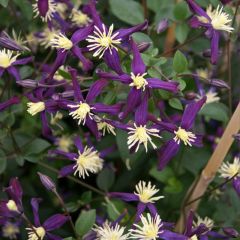
Clematis flammula Aromatica
- Flowering time August to October
- Height at maturity 1,50 m
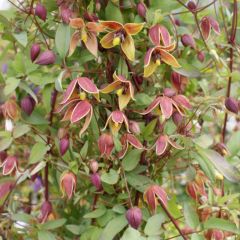
Clematis My Angel - Golden Clematis
- Flowering time August to November
- Height at maturity 3 m
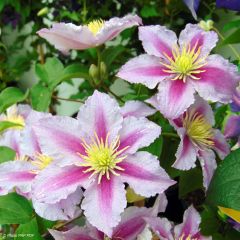
Clematis patens Piilu
- Flowering time June to November
- Height at maturity 2 m
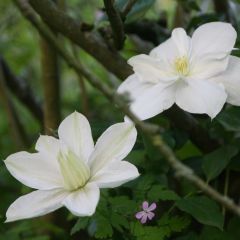
Clematis patens Madame Lecoultre
- Flowering time July to October
- Height at maturity 2,50 m
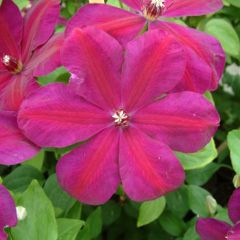
Clematis x patens Westerplatte
- Flowering time July to October
- Height at maturity 2 m
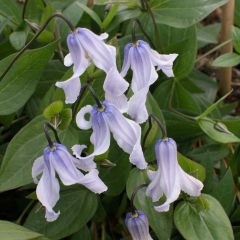
Clematis Twinkle
- Flowering time June to October
- Height at maturity 1 m
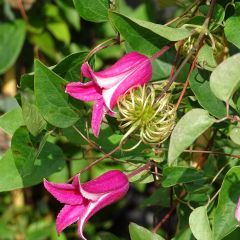
Clematis texensis Princess Diana - Scarlet Leather Flower
- Flowering time September to November
- Height at maturity 1,50 m
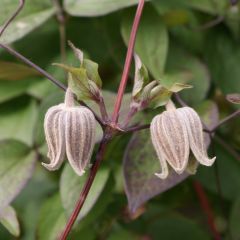
Clematis fusca
- Flowering time July to October
- Height at maturity 1,50 m
Discover other Clematis A to Z
Planting Clematis
Where to plant?
Clematis is a fussy plant: you need to find the perfect spot it will love! It enjoys having its head in the sun and its feet in the shade. Above all, it needs plenty of light. Place it in full sun alongside perennials or small shrubs that will shade its base. However, some hybrids, like Clematis ‘Nelly Moser’, should be planted in lightly shaded areas. In full sun, they would lose the intensity of their colours!
Clematis absolutely need deep soil, as their strong roots penetrate far underground. Shallow or compacted soils won’t suit them, which is why we recommend working the soil deeply before planting to loosen and aerate it.
Clematis thrives in rich, humus-rich soils. If your soil is poor, you can enrich it with compost. The soil should remain cool but well-drained, as clematis hates excess moisture (especially in winter), as well as drought. It will also appreciate being planted in a sheltered spot from the wind, which could damage its fragile stems. Avoid overly confined spaces (such as squeezed between a wall and other plants), which encourage fungal diseases. Clematis is demanding: if it doesn’t grow, move it!
You can also plant it in a pot and place it on a balcony or terrace. For this purpose, choose the most compact varieties! Lastly, know that you don’t have to train your clematis to climb—you can also let it sprawl over the ground or a slope! For example, the variety ‘Robert Brydon’ makes an excellent ground cover, forming a carpet of mauve flowers.
Also read our article How to Fail at Planting Your Climbers?
When to plant?
Planting is possible year-round, avoiding periods of heavy frost or extreme heat, but the ideal time is in spring.
How to plant?
Provide a support. Unlike ivy, which clings directly to walls using its aerial roots, clematis needs a trellis to twine its tendrils and climb.
- Soak the root ball in a bucket of water
- Dig a deep planting hole
- Add a layer of drainage at the bottom of the hole
- Mix garden soil with compost and fertiliser
- Place the root ball at an angle, tilted towards its support
- Water generously and guide the stems towards the support
For more details and tips, see our dedicated guide: Planting Clematis.
You can mulch with pine bark to keep the soil cool. We also recommend planting perennials around the base to protect it from the sun. Continue watering in the weeks after planting. And watch out for slugs or snails that might nibble on young plants! You can also plant clematis in pots.
Follow our video guide for planting clematis!
How to care for your clematis?
Apart from their size, clematis require relatively little maintenance. You can regularly remove faded flowers, except for varieties that produce decorative fruits. Add some compost in early spring. Water your clematis only in midsummer, avoiding direct watering at the base of the stems. The rest of the time, there’s no need to water unless there’s a drought. Be especially careful about excess moisture: avoid waterlogging the soil!
How to combat common clematis diseases?
Large-flowered hybrid varieties are more susceptible to diseases than others. They are much more fragile than small-flowered varieties. The main problem with clematis is caused by a fungus, Ascochyta clematidina, which can devastate a plant in just 24 hours! Your clematis may have seemed healthy and vigorous, even about to bloom, but suddenly its leaves start drying out! Before you can react, it’s already completely wilted… This devastating disease prevents sap circulation, causing tissue death. Cut the plant at the base of the stems, a few centimetres below the soil (as the fungus lives on the surface), and replace the soil around the stems to a depth of several centimetres with healthy, uncontaminated substrate. The plant may regrow from the base. Limit watering: moisture encourages this disease.
Clematis are susceptible to gastropods (slugs and snails), which happily nibble on young shoots! You can protect newly planted clematis by spreading ash or wood chips around the base as a barrier. They can also be attacked by aphids. If you notice curled, sticky leaves, spray with black soap or a pyrethrum-based solution.
Best practices for pruning your clematis
Pruning your clematis will result in a well-branched plant with a more compact habit and will encourage flowering (provided it’s done at the right time!). First and foremost, disinfect your secateurs to avoid spreading diseases from one clematis to another. When working on affected plants, discard the stems and leaves you cut.
Prune early-flowering varieties and evergreen varieties in late spring, around May, once flowering has finished. Carry out very light pruning. If you prune too early, between autumn and early spring, you risk cutting branches that would bear flowers, thus limiting flowering! These varieties can even go without pruning.
For other varieties, later-flowering and large-flowered, prune before regrowth begins, between February and March. You can prune them more severely! Don’t hesitate to cut back every other branch to 30 or 40 centimetres above the ground. Also remove dead shoots. A second pruning after flowering is possible.
→ Learn more in our advice sheet: Why isn’t my clematis flowering? and in our tutorial: winter pruning of clematis.
Clematis Propagation Techniques
You can propagate your clematis by taking cuttings or by layering. We recommend taking cuttings as the simplest method. As for sowing, it’s tricky to achieve, and the seeds can sometimes take a very long time to germinate.
Introduction to propagating clematis from cuttings
You can take cuttings from clematis in late spring, in June or July.
- Start by preparing a pot: place a layer of gravel or clay pebbles at the bottom for drainage, then fill the pot with a mix of compost and sand.
- Next, cut a stem about 15 cm long using a knife or secateurs.
- Remove any leaves at the base of the stem, if present.
- Leave only a few leaves on the cutting, then plant it in the pot and firm the soil around the stem.
- Water and cover the pot with clear plastic or a cut plastic bottle to maintain a humid atmosphere.
- Place your pot under a cold frame, away from direct sunlight.
You’ll need to wait until the following spring to plant the clematis in the ground.
Layering clematis
You can propagate clematis by layering. This technique allows you to quickly obtain new plants. Carry this out in summer, around August. Layering is done by bending down woody stems.
Layering clematis is best done in a pot. To make the process easier, choose a fairly wide pot (at least 15 cm in diameter).
- Place a layer of gravel at the bottom for drainage, then fill it with compost.
- Choose a long stem, trim the leaves, keeping only those at the tip of the branch.
- Make a small incision in the bark on the section you’ll bury.
- Then, place it in the soil and cover with compost.
- Lift the tip of the stem and support it vertically with a stake.
- Firm the soil and water.
To learn more, read our practical guide on propagating clematis from cuttings.
Clematis Companions: General Advice
Clematis pair wonderfully with roses, whether climbing or shrub varieties. Together, they create a romantic atmosphere, full of softness and delicacy. Many varieties offer pastel blooms in shades of pink, white or mauve. Discover Clematis montana ‘Mayleen’: in spring it bears a multitude of soft pink flowers, bringing great charm to the garden. You could also pair the white flowers of clematis ‘Summersnow’ with the pale pink blooms of climbing rose ‘Coral Dawn’.
In all cases, we recommend planting other perennials around clematis: they’ll protect the base from sun and help keep the soil cool. Take the opportunity to plant some hardy geraniums, for example. If your clematis base becomes bare or lacks flowers, they’ll add colour without fail!
Don’t hesitate to mix different clematis varieties! Explore our collections. You can combine them with other climbers like akebias or jasmines.
Let them climb your trees and shrubs… If you grew them for their decorative foliage, they’ll now have the added interest of being covered in a multitude of starry flowers! You could also train them up fruit trees, for example by planting a clematis montana at the base of an apple or cherry tree.
The most compact varieties adapt perfectly to container growing. They’ll add colour to your patios and balconies! Plant them in large pots with some perennials or bulbs, like hyacinths, anthemis or verbenas. If you have a shady spot, combine your clematis with the decorative foliage of ivies or ferns.
Herbaceous clematis integrate very easily into flower beds. You could pair Clematis heracleifolia with the light foliage of ornamental grasses and aster flowers.

Clematis ‘Snow queen’ and tulip ‘Ballade’! (Copyright MAP Clive Nichols)
For more specific pairing ideas in different situations, see our advice: Clematis – 7 successful pairing ideas and Pairing herbaceous clematis.
Useful resources
- Find the finest selection of clematis right here!
- We offer plenty of advice on the following topics: Choosing your clematis – Planting clematis – Planting clematis in pots – How to train and stake clematis – Evergreen clematis: planting and cultivation – Pruning and caring for clematis – Treating clematis diseases – Propagating clematis from cuttings – Clematis companion planting – Winter pruning of clematis – How to prune winter-flowering clematis? – How to easily propagate clematis?
- A blog post by Pierre: Clematis viticella, the beautiful Italian!
- Our video guide on how to plant clematis;
- Our advice sheet: Clematis montana, the best varieties; Planting herbaceous clematis; Choosing herbaceous clematis
- Our advice sheets: 7 clematis with unusual blooms; 7 clematis with continuous flowering; the most spectacular clematis; Bell-flowered clematis: our top 5
- Our advice sheets: 7 tall clematis; 7 perfect pot-grown clematis
- An article by Didier Willery: Large-flowered clematis: guaranteed spectacle! published in L’Ami des jardins et de la maison (June 2012)
- Also check out the book: Clematis, how to use them in the garden, by Didier Willery and Arnaud Travers, published by Ulmer, 2010
- Learn more about Clematis viticella with: red viticella clematis, blueish viticella clematis, pink viticella clematis and the most beautiful viticella clematis, 7 purple or red viticella clematis
- Advice sheet: 5 very hardy climbing plants, 5 climbers that won’t damage walls
- Clematis by season: 6 winter-flowering climbers; 6 winter-flowering clematis; 7 spring-flowering clematis; 8 autumn-flowering clematis
- Clematis by flower colour: 8 must-have blue-flowered climbers, 6 must-have white-flowered climbers, 8 red-flowered climbers, 7 pink-flowered climbers; Pink-flowered herbaceous clematis; Discover 9 blue-flowered herbaceous clematis; 5 white-flowered herbaceous clematis; Purple and mauve-flowered herbaceous clematis: our top 5.
Frequently asked questions
-
My clematis is suddenly drying out! What should I do?
It is likely suffering from the disease caused by the fungus *Ascochyta clematidina* (also known as *Phoma clematidina*). This dramatic disease causes sudden stem dieback in no time. Avoid the combination of heat and humidity, which favours the development of this disease. We recommend cutting the stems a few centimetres below ground level. The plant should regrow from the base. Since this fungus infects the soil, you should remove the top 10 cm of soil and replace it with healthy growing medium.
-
My clematis looks wilted!
The soil is likely too wet. Reduce watering, and especially avoid watering directly at the base of the stems. If you've applied mulch, remove it. Consider moving the plant to better-draining ground. Waterlogged soil can cause root rot!
-
The flowers of my clematis are turning pale and losing their vibrancy!
If they take on green or very pale hues, this may be due to temperatures being too low during the growth of the flower buds. They should regain their usual colour as the season progresses. This issue mainly affects clematis with white flowers (which then turn green) or rather pale blooms. It also happens that large-flowered hybrids take on duller tones in full sun. We recommend planting Clematis 'Nelly Moser', for example, in partial shade.
-
The leaves of my clematis are curling up and becoming sticky!
The culprits are aphids. They pierce the leaves, causing them to deform and promoting the development of diseases. Spray with black soap or a pyrethrum-based solution.
-
My clematis isn't flowering... or barely flowering at all! (Note: I've maintained the informal, slightly exasperated tone of the original while adapting it to British English conventions. The exclamation mark and ellipsis are preserved for stylistic effect, as they would appear in gardening advice for UK audiences.)
If your clematis is struggling to flower, it's likely that the growing conditions aren't suitable. The soil should be cool yet well-draining. Make sure its base is shaded, while the rest of the plant receives enough sunlight!
Flowering may also be hindered if you prune the clematis at the wrong time, removing the stems where the flowers should bloom. This can happen if you prune early-flowering clematis (such as *Clematis montana* or *alpina*) or evergreen varieties in winter or early spring. You risk preventing flowers from appearing by cutting the branches where they should bloom.
On the other hand, pruning at the right time will encourage the development of flower buds and make the flowering even more abundant.
-
The flowers on my clematis are different from what was expected!
Some large-flowered hybrids produce double blooms in spring and then single flowers in autumn. Don't be surprised if a double-flowered variety gives you single blooms in summer or autumn!
- Subscribe!
- Contents


































